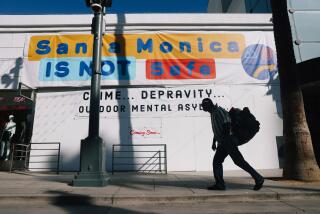Getting New York to pipe down
- Share via
NEW YORK — He got New Yorkers to stop smoking in public buildings, bars and restaurants, and the city’s dining spots will soon be free of trans fats. But can Mayor Michael R. Bloomberg deliver on his vow to make the Big Apple less noisy?
Last week, a much-ballyhooed noise control ordinance went into effect, targeting some of the worst offenders in the cacophony of everyday urban life: Mister Softee ice cream trucks, whose tinkling jingles play over and over; nightclub operators, whose rowdy music blares in otherwise quiet neighborhoods; and dogs barking at all hours of the day and night.
The goal of the law is to give the city that never sleeps “much-deserved peace and quiet,” Bloomberg said when he signed it last year. The fines for violating noise levels have risen -- ranging from less than $100 for a barking dog to thousands of dollars for repeat nightclub offenders.
Bloomberg, who quit the Republican Party last month and is now an independent, has hailed the law as “the first comprehensive overhaul” of local noise legislation in 30 years.
“I think it’s great they’re trying to do something about all of this,” said James Titus, a Mount Vernon, N.Y., retiree out for a stroll in Midtown. As he spoke, two cars passed by with radios booming salsa music; a fire engine roared up the street with its siren blaring; jackhammers echoed from a building under construction.
“But I don’t know if they can solve this problem,” Titus added. “There’s noise everywhere.”
To give the law some teeth, the city Department of Environmental Protection is assigning 45 agents to screen complaints about chronic noise, especially in clubs and homes. They’ll be armed with some tough new guidelines: Nightclubs may not blast music that is “plainly audible” (defined as 7 decibels) more than 15 feet from their front doors.
Noise is the “No. 1 quality-of-life issue” for residents, said the mayor, calling the law “a key element” of his agenda. Public sentiment appears to be on his side. Noise complaints topped the list of problems called in to the city’s 311 nonemergency hotline in the last 12 months: More than 278,000 were logged since last July, most of them about loud neighbors.
“The idea is that we’ll see a gradual difference in noise over time, not right away,” said spokesman Michael Saucier of the Environmental Protection Department, which administers the new law. “This is a complaints-driven system about noise, and the public serves as our ears.” His department’s agents will be responding to long-term complaints, he explained, but police will respond to complaints as they happen.
New York is not the only city to tackle such a problem. Strong anti-noise initiatives have been implemented in recent years from Alameda, Calif., to Sarasota, Fla.
And unlike Bloomberg’s 2003 crusade against smoking, his noise regulations have generated little controversy.
Yet some believe this initiative may meet the fate of other “quality of life” campaigns. In the late 1980s, for example, Mayor Edward I. Koch, responding to an outcry over the number of severely mentally ill homeless people on the streets, endorsed a policy of taking them to hospitals for treatment and observation. The initiative was slowed by a lawsuits, bureaucratic wrangles, and disputes over hospital space.
Nearly 10 years later, Mayor Rudolph W. Giuliani announced a crackdown on jaywalking, proposing stiff fines and police enforcement. It, too, stalled, widely derided as an example of City Hall going against the grain of New York life.
Some skeptics think the biggest obstacle to Bloomberg’s initiative is the officially sanctioned daily noise in the streets, parks, neighborhoods, tunnels and subways. The daily racket seems beyond regulation, critics say.
As July 4 dawned quietly over Manhattan’s Upper West Side, for example, the calm was shattered at 8 a.m., when a Con-Edison construction crew began tearing up the street in the heart of a densely populated residential neighborhood. Noise echoed up and down the canyon of tall apartment buildings, but the Con-Edison repair crew said it had all the necessary clearance to do such work on a holiday morning.
“Can you believe this noise?” asked Mike Ramirez, pedaling past on a bicycle. “People are still sleeping! I don’t know what you do about something like this.”
A few days later, subway commuters at the Union Square station were treated to a harsh squealing of brakes as a passenger train twisted through a tunnel into the station. A conductor on another train made announcements as the brake noise enveloped the station. It was almost impossible to understand him.
A little over a mile away, cars were barreling out of a Midtown tunnel onto Park Avenue, their din overwhelming. Brett Tolino, a magazine production staffer out for an afternoon cigarette break, scoffed at the idea that the city could -- or should -- make a dent in the volume.
“They’re regulating us to death here,” he snapped. “If New York is anything, it’s noise. So get over it. If you don’t like the sounds here, move somewhere else.”
Saucier conceded the inevitability of noise. But he noted: “The point of the new law is not to shut everything down. We just want to try and strike a balance, because New Yorkers deserve as much peace as they can get in a city of 8.2 million people.”
More to Read
Sign up for Essential California
The most important California stories and recommendations in your inbox every morning.
You may occasionally receive promotional content from the Los Angeles Times.













